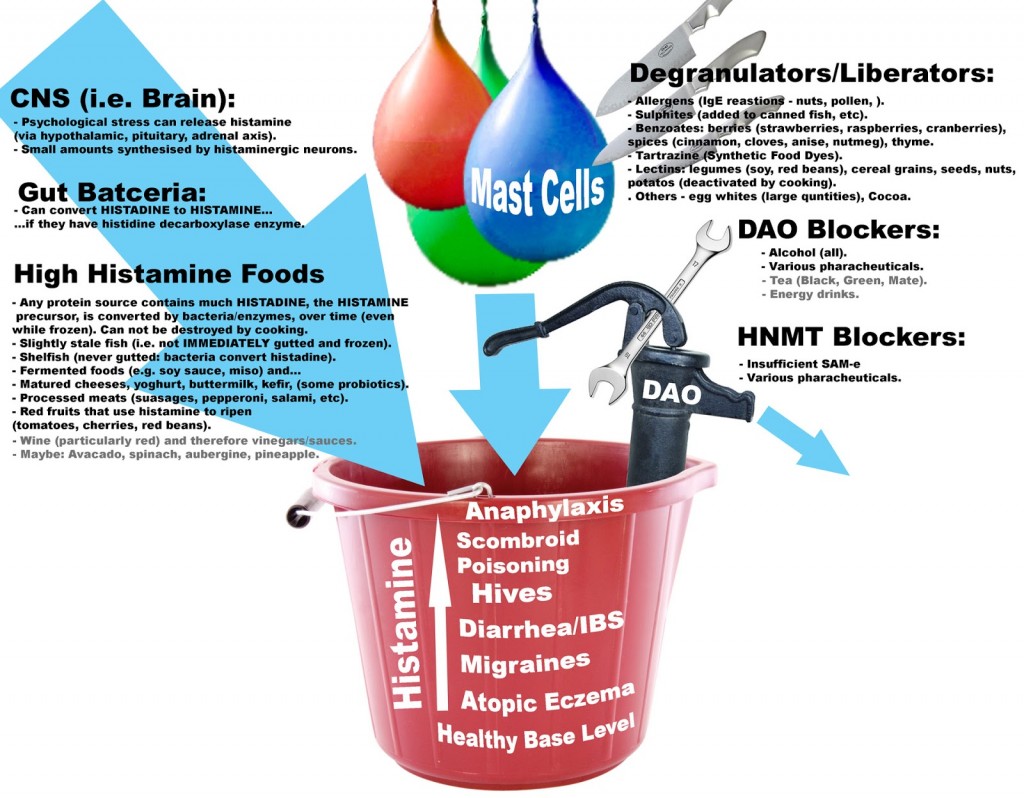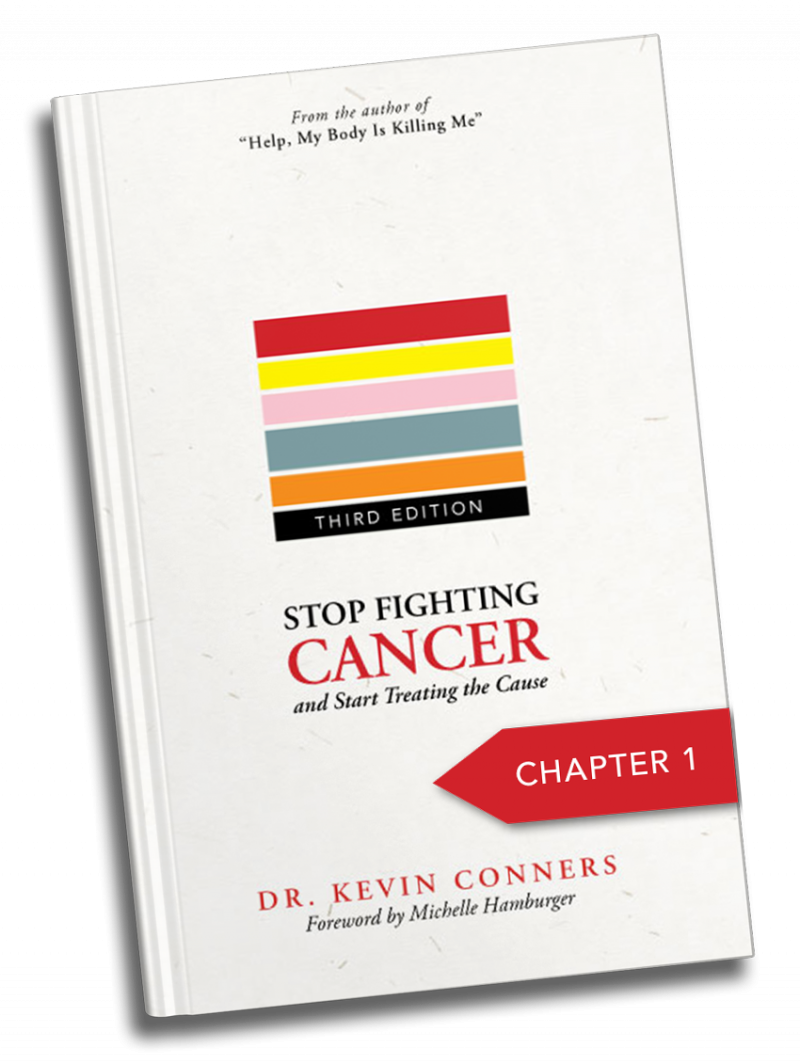What is Histamine?
Jump to the list of 3 easy steps
Histamine is an inflammatory chemical that your body makes for very specific purposes. As the need for histamine diminishes, an enzyme made through the HNMT genes quickly rid the tissues of excess histamine. People with defects in the HNMT genes retain excess histamine (NOT good) that greatly increase systemic inflammation and can contribute to numerous symptoms.
Many foods also contain high levels of histamine that, when ingested, absorb and then contribute to our overall histamine levels in our tissues, thereby increasing inflammation.
As we cover your particular genetic variants, patients that have HNMT and/or ABP1 defects can help themselves by reducing extra histamine loads gained through your diet. Dietary restriction of high histamine foods can help lower tissue levels and greatly reduce a patient's symptoms.
See this list of foods that are high in histamine.
More about Histamine You Probably Didn't Know
Histamine is a chemical which occurs naturally in certain foods and is created in the body cells to deal with certain irritants. It is a tiny messaging molecule that some cells use to communicate with each other. It is naturally found in all kinds of plants and animals and is best known for its role in the body’s allergic response.
Histamine is versatile–it helps to regulate body functions as diverse as digestion, sleep, sexual function, blood pressure, and brain function. How does this one molecule do so many different things? The secret to histamine’s multi-faceted nature lies in which type of cell and which type of receptor it binds to. For example, when histamine binds to special cells in the stomach called parietal cells, they respond by producing stomach acid.
When histamine binds to receptors on the surface of blood vessel cells, blood vessels dilate, dropping blood pressure. Small vessels called capillaries become leaky and fluids ooze out of them, which can lead to runny nose, watery eyes, and puffy skin/fluid retention. In the brain, histamine acts as a neurotransmitter, carrying chemical messages between nerve cells.
So you can see that histamine isn’t bad. However, people with defects in their ABP and/or HNMT genes have a more difficult time breaking down histamine in the GUT and in the tissues thereby leaving them with HIGH histamine levels and the symptoms that accompany such a problem.
What are Some Symptoms of High Histamine?
“The term “histamine intolerance” was introduced as common denominator for symptoms such as abdominal pain, flatulence, diarrhea, headache, pruritus (itching), blepharedemas (puffy eyes), urticaria (hives), rhinorrhea (runny nose), dysmenorrhea (menstrual cycle problems), respiratory obstruction (difficulty breathing), tachycardia (racing heart), extrasystoles (heart palpitations) and hypotension (low blood pressure) occurring after the consumption of histamine-rich foods.” [Komericki 2010]

Women seem to have more issues than men with histamine intolerance because estrogen and histamine reinforce each other, i.e. histamine can increase estrogen levels and vice versa. This explains why histamine intolerance can be associated with pre-menstrual cramps and menstrual migraine. Even more fascinating is that pregnant women may experience relief from food sensitivities during pregnancy because the placenta secretes very high amounts of diamine oxidase, or DAO, the enzyme that destroys histamine in the gut.
However, it is primarily a genetic variant that produces high histamine levels in most individuals.

Diet for Decreasing Histamine
The following lists are foods that should be avoided
Histamine-Rich Foods
- Fermented alcoholic beverages, especially wine, champagne and beer
- Fermented foods: sauerkraut, vinegar, soy sauce, kefir, yogurt, kombucha, etc
- Vinegar-containing foods: pickles, mayonnaise, olives
- Cured meats: bacon, salami, pepperoni, luncheon meats and hot dogs
- Soured foods: sour cream, sour milk, buttermilk, soured bread, etc
- Dried fruit: apricots, prunes, dates, figs, raisins
- Most citrus fruits
- Aged cheese including goat cheese
- Nuts: walnuts, cashews, and peanuts
- Vegetables: avocados, eggplant, spinach, and tomatoes
- Smoked fish and certain species of fish: mackerel, mahi-mahi, tuna, anchovies, sardines
Histamine-Releasing Foods
- Alcohol
- Bananas
- Chocolate
- Cow’s Milk
- Nuts
- Papaya
- Pineapple
- Shellfish
- Strawberries
- Tomatoes
- Gluten
- Wheat Germ
- Many artificial preservatives and dyes
How Does My Body Get Rid of Histamine?
Once formed, histamine is broken down by an enzyme called diamine oxidase (DAO) in the digestive tract. Those with ABP1 defects lack the ability to make the DAO enzyme. In the brain and other tissues, it is broken down primarily by histamine N-methyltransferase (HMT) and those with HNMT genetic defects lack the ability to make such enzymes. So, digestive issues such as Leaky Gut and Gluten Intolerance or any other inflammatory process in the gut simply adds to the inability to breakdown dietary histamine since deficiencies in DAO and/or methyl groups also increases symptoms of histamine intolerance.
Causes of Low DAO
- Genetic mutations (ABP1 and HNMT gene defects)
- Gluten intolerance
- Leaky gut
- Dysbiosis in the Gut
- DAO-blocking foods: alcohol, energy drinks, and tea
- Inflammation from Crohn’s, ulcerative colitis, and inflammatory bowel disease.
- Medications:
- Non-steroidal anti-inflammatory drugs (ibuprofen, aspirin)
- Antidepressants (Cymbalta, Effexor, Prozac, Zoloft)
- Immune modulators (Humira, Enbrel, Plaquenil)
- Antiarrhythmics (propanolol, metaprolol, Cardizem, Norvasc)
- Antihistamines (Allegra, Zyrtec, Benadryl)
- Histamine (H2) blockers (Tagamet, Pepcid, Zantac)
***Although histamine blockers, a class of acid-reducing drugs, seem like they would help prevent histamine intolerance, these medications can actually deplete DAO levels in your body.
How to Treat Histamine Intolerance?
- Do your best to remove the high histamine foods for 1-3 months.
- Add in a supplement of DAO by taking two pills at each meal - HistaClear is the best DAO to breakdown dietary histamines . Clear Histamine Scavenger and Natural Clear Hist are common supplements we use to help reduce systemic histamine levels and can be purchased from our store. For children, we use a great tasting chewable - ClearHist Jr.
- Most importantly, find the root cause for the histamine intolerance (other than the genetics). If you're on a medication that is causing the intolerance, working with your physician to wean off of these medications is essential. Some of the primary causes are gut dysbiosis and gluten intolerance, which cause a leaky gut. Other causes can be a chemical sensitivity. These can range from heavy metal toxicity to sensitivity to colorings, dyes, paint chemicals, fluoride, chlorine, fire-retardant chemicals to a wide variety of pesticides or just about anything you can imagine.
3 Easy Steps to Clear Histamine from the Body
- Avoid Foods with High Histamine
- Avoid Foods/chemicals/drugs that Release Histamine in your Your Body and find out if toxicity is a cause (it usually is).
- Support DAO Levels with Nutrition
Our FOUR-STEP Protocol
1. What is the CAUSE and how are we going to get RID of it?
2. What specific Nutraceutical will work for YOUR condition?
3. What specific FREQUENCIES will work for YOUR condition?
4. What other SUPPORT is necessary (other organs, brain, diet…)?



 In this Brand New 3rd Edition Dr. Kevin Conners adds almost DOUBLE the content with all new insights and practical tips on how to understand your body’s ability to heal and get back to a state of health.
In this Brand New 3rd Edition Dr. Kevin Conners adds almost DOUBLE the content with all new insights and practical tips on how to understand your body’s ability to heal and get back to a state of health.